外研版九年级下册Module 6 Eating together Unit 3 Grammar课件(共15张PPT)
文档属性
| 名称 | 外研版九年级下册Module 6 Eating together Unit 3 Grammar课件(共15张PPT) |  | |
| 格式 | pptx | ||
| 文件大小 | 933.6KB | ||
| 资源类型 | 教案 | ||
| 版本资源 | 外研版 | ||
| 科目 | 英语 | ||
| 更新时间 | 2025-04-27 20:28:52 | ||
图片预览

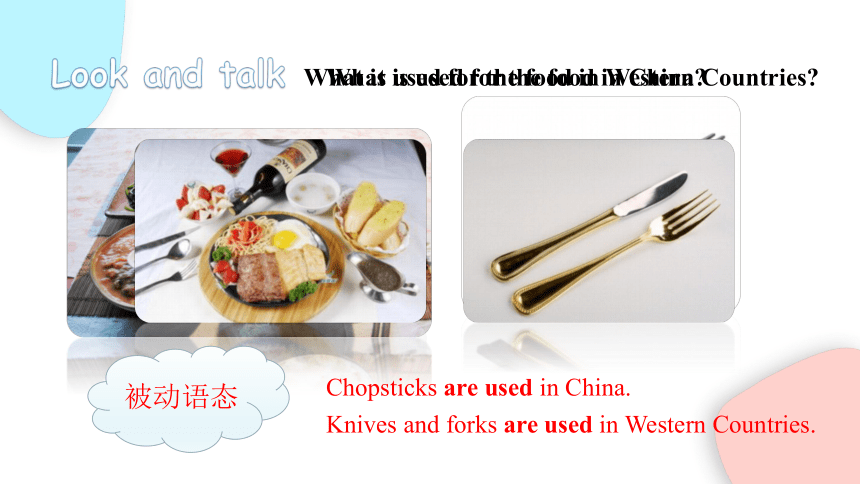
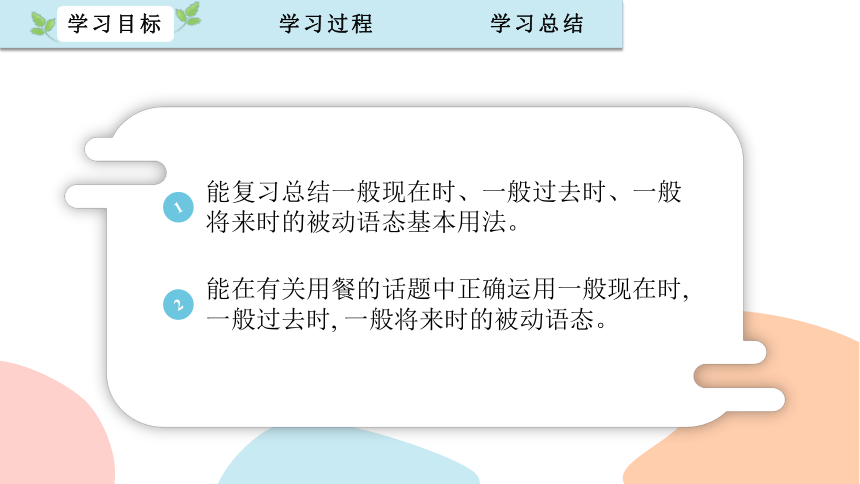
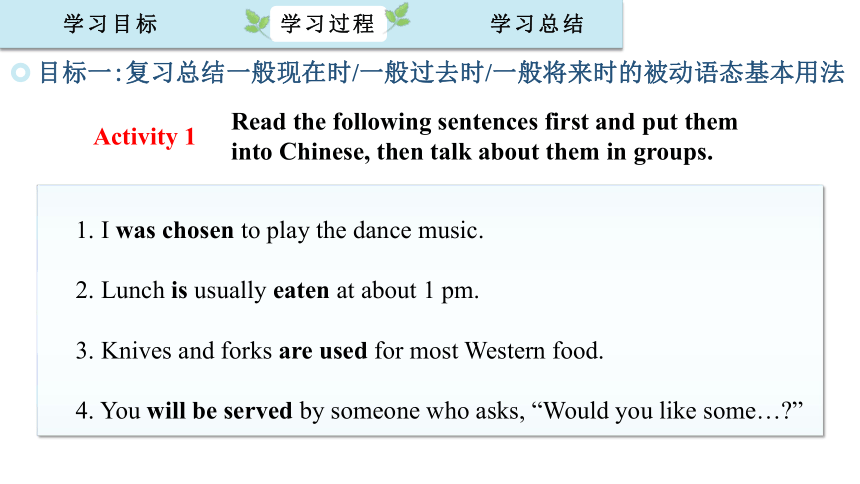
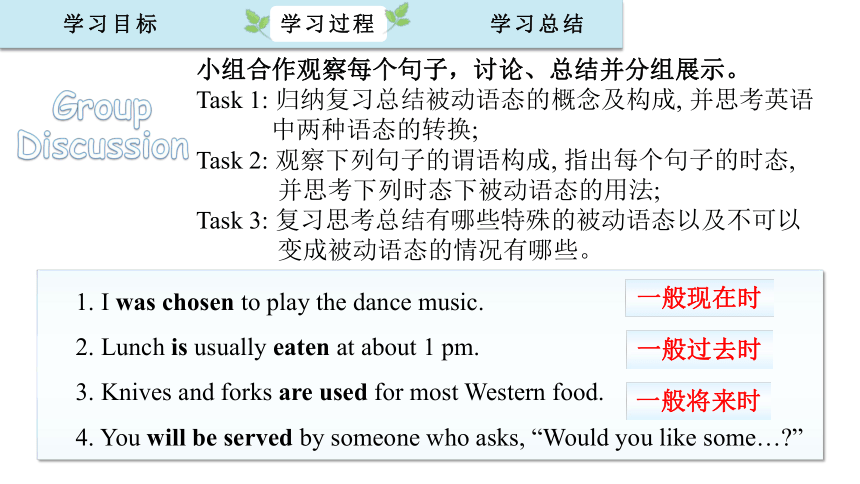
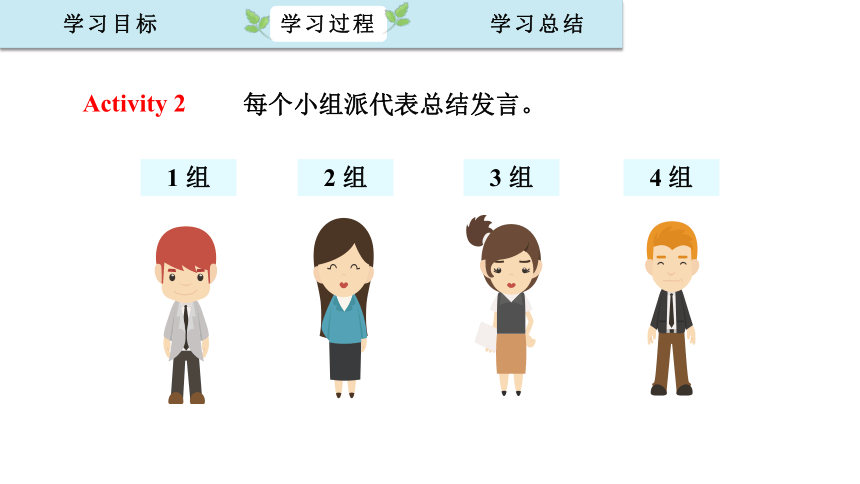
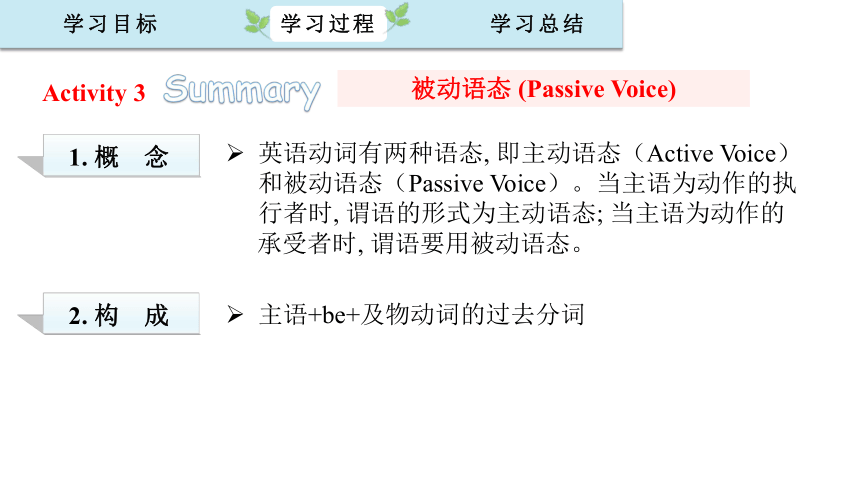
文档简介
(共15张PPT)
Module 6 Unit 3
Language in use
Grammar
Look and talk
What is used for the food in China
Chopsticks are used in China.
What is used for the food in Western Countries
Knives and forks are used in Western Countries.
被动语态
1
2
能复习总结一般现在时、一般过去时、一般将来时的被动语态基本用法。
能在有关用餐的话题中正确运用一般现在时,一般过去时, 一般将来时的被动语态。
目标一:复习总结一般现在时/一般过去时/一般将来时的被动语态基本用法
Activity 1
Read the following sentences first and put them
into Chinese, then talk about them in groups.
1. I was chosen to play the dance music.
2. Lunch is usually eaten at about 1 pm.
3. Knives and forks are used for most Western food.
4. You will be served by someone who asks, “Would you like some… ”
Group
Discussion
小组合作观察每个句子,讨论、总结并分组展示。
Task 1: 归纳复习总结被动语态的概念及构成, 并思考英语
中两种语态的转换;
Task 2: 观察下列句子的谓语构成, 指出每个句子的时态,
并思考下列时态下被动语态的用法;
Task 3: 复习思考总结有哪些特殊的被动语态以及不可以
变成被动语态的情况有哪些。
1. I was chosen to play the dance music.
2. Lunch is usually eaten at about 1 pm.
3. Knives and forks are used for most Western food.
4. You will be served by someone who asks, “Would you like some… ”
一般将来时
一般过去时
一般现在时
Activity 2
每个小组派代表总结发言。
1 组
2 组
3 组
4 组
Activity 3
Summary
1. 概 念
被动语态 (Passive Voice)
2. 构 成
英语动词有两种语态, 即主动语态(Active Voice)和被动语态(Passive Voice)。当主语为动作的执行者时, 谓语的形式为主动语态; 当主语为动作的
承受者时, 谓语要用被动语态。
主语+be+及物动词的过去分词
3. 语态转换
主动语态 被动语态
含义 主语是动作的执行者 主语是动作的承受者,即行为动作的对象
例句 George cut down the cherry tree. The cherry tree is cut down by George.
说明 谓语cut这一动作由主语George来执行 主语the cherry tree是cut这一动作的承受者
主动语态变被动语态:
1. 将主动句中的宾语成分变为被动句中的主语成分, 若主动句中的宾语
是人称代词,要将宾格变为主格。
2. 把主动句中的主语变为被动句中的宾语, 主格代词变为宾格代词, 并
做 by 的宾语。
3. 谓语动词变成相应的被动形式。
4. 各种时态的被动语态
时态 构成 例句
一般现在时 am/is/are +动词过去分词 Knives and forks are used for most Western food.
一般过去时 was/were +动词过去分词 The play was performed by the Beijing English Theatre Company.
一般将来时 be going to/will be +动词过去分词 You are going to / will be invited to a big meal.
除时态以外, 还应该注意短语动词在被动语态中的用法:
e.g.Old people are taken good care of in China./A notice will be put up on the wall.
可以看出, take care of, put up等短语动词的被动语态与单个动词的被动语态构成方式相同。
5. 一些特殊的被动语态
1. 有些动词可以有两个宾语, 在用于被动结构时, 可以把主动结构中的
一个宾语变为主语, 另一宾语仍然保留在谓语后面。通常变为主语的
是间接宾语(指人的宾语)。
e.g. They didn’t offer Ann the job. →Ann wasn’t offered the job.
2. 在使役动词have, make, get以及感官动词see, watch, notice, hear, feel,等
后面不定式作宾语补语时, 在主动结构中不定式to要省略, 但变为被动
结构时, 要加to。
e.g. They make her clean the floor. →She is made to clean the floor by them.
3. It+be+过去分词+that从句 (=主语+be +过去分词+to do sth.)
表示:据说/据报道/据悉/据信等……
e.g. It is said that the boy has passed the national exam.
→The boy is said to have passed the national exam.
6. 不可以变成被动语态的情况
1. 某些感官动词加形容词及少数其他的动词本身可以表示被动意义。
smell, taste, prove, sell, etc.
e.g. The dish tastes delicious./The theory proved right at last.
2. need + V- ing表示“主语承受动词发出的动作”, 表示被动意义。
e.g. My car needs repairing. (= to be repaired).
3. 通常只有及物动词(组)才有被动语态, 不及物动词没有。
e.g. The war broke out. (√)
The war was broke out. (×)
目标二:在有关用餐的话题中正确运用一般现在时/一般过去时/一般将来时的被动语态
Activity 1
1
Complete the explanations of the signs.
LUNCH SERVED
DAILY FROM 12
PM TO 2 PM
Don’t take food into
the meeting rooms
1. Lunch _________ daily from
12 pm to 2 pm.
is served
2. Food _________________ into
the meeting rooms.
should not be taken
Park open
for picnics
Dogs not
allowed
Closed until
10 am
3. The park _________ for picnics.
is open
4. Dogs ______________ in the restaurant.
are not allowed
5. The shop _________ until 10 am.
is closed
Activity 2
2
Complete the passage with the correct form of the words in brackets.
Guests at a new restaurant in London (1)__________ (serve) by blind waiters. But the waiters are not the only people who cannot see. The guests cannot see either, because the restaurant (2)________ (keep) dark. No lights (3)___________ (allow), not even the light on your mobile phone. The idea is that when you cannot see, your sense of taste (4)___________(improve). “Don’t worry that you won’t enjoy food without seeing it. You can (5)______ (enjoy) it using your nose, fingers and tongue instead,” promises the restaurant manager.
are served
is kept
are allowed
is improved
enjoy
综合上述目标,说说我们今天的收获。
学习目标
1
2
能复习总结一般现在时、一般过去时、一般将来时的被动语态基本用法。
能在有关用餐的话题中正确运用一般现在时,一般过去时, 一般将来时的被动语态。
Module 6 Unit 3
Language in use
Grammar
Look and talk
What is used for the food in China
Chopsticks are used in China.
What is used for the food in Western Countries
Knives and forks are used in Western Countries.
被动语态
1
2
能复习总结一般现在时、一般过去时、一般将来时的被动语态基本用法。
能在有关用餐的话题中正确运用一般现在时,一般过去时, 一般将来时的被动语态。
目标一:复习总结一般现在时/一般过去时/一般将来时的被动语态基本用法
Activity 1
Read the following sentences first and put them
into Chinese, then talk about them in groups.
1. I was chosen to play the dance music.
2. Lunch is usually eaten at about 1 pm.
3. Knives and forks are used for most Western food.
4. You will be served by someone who asks, “Would you like some… ”
Group
Discussion
小组合作观察每个句子,讨论、总结并分组展示。
Task 1: 归纳复习总结被动语态的概念及构成, 并思考英语
中两种语态的转换;
Task 2: 观察下列句子的谓语构成, 指出每个句子的时态,
并思考下列时态下被动语态的用法;
Task 3: 复习思考总结有哪些特殊的被动语态以及不可以
变成被动语态的情况有哪些。
1. I was chosen to play the dance music.
2. Lunch is usually eaten at about 1 pm.
3. Knives and forks are used for most Western food.
4. You will be served by someone who asks, “Would you like some… ”
一般将来时
一般过去时
一般现在时
Activity 2
每个小组派代表总结发言。
1 组
2 组
3 组
4 组
Activity 3
Summary
1. 概 念
被动语态 (Passive Voice)
2. 构 成
英语动词有两种语态, 即主动语态(Active Voice)和被动语态(Passive Voice)。当主语为动作的执行者时, 谓语的形式为主动语态; 当主语为动作的
承受者时, 谓语要用被动语态。
主语+be+及物动词的过去分词
3. 语态转换
主动语态 被动语态
含义 主语是动作的执行者 主语是动作的承受者,即行为动作的对象
例句 George cut down the cherry tree. The cherry tree is cut down by George.
说明 谓语cut这一动作由主语George来执行 主语the cherry tree是cut这一动作的承受者
主动语态变被动语态:
1. 将主动句中的宾语成分变为被动句中的主语成分, 若主动句中的宾语
是人称代词,要将宾格变为主格。
2. 把主动句中的主语变为被动句中的宾语, 主格代词变为宾格代词, 并
做 by 的宾语。
3. 谓语动词变成相应的被动形式。
4. 各种时态的被动语态
时态 构成 例句
一般现在时 am/is/are +动词过去分词 Knives and forks are used for most Western food.
一般过去时 was/were +动词过去分词 The play was performed by the Beijing English Theatre Company.
一般将来时 be going to/will be +动词过去分词 You are going to / will be invited to a big meal.
除时态以外, 还应该注意短语动词在被动语态中的用法:
e.g.Old people are taken good care of in China./A notice will be put up on the wall.
可以看出, take care of, put up等短语动词的被动语态与单个动词的被动语态构成方式相同。
5. 一些特殊的被动语态
1. 有些动词可以有两个宾语, 在用于被动结构时, 可以把主动结构中的
一个宾语变为主语, 另一宾语仍然保留在谓语后面。通常变为主语的
是间接宾语(指人的宾语)。
e.g. They didn’t offer Ann the job. →Ann wasn’t offered the job.
2. 在使役动词have, make, get以及感官动词see, watch, notice, hear, feel,等
后面不定式作宾语补语时, 在主动结构中不定式to要省略, 但变为被动
结构时, 要加to。
e.g. They make her clean the floor. →She is made to clean the floor by them.
3. It+be+过去分词+that从句 (=主语+be +过去分词+to do sth.)
表示:据说/据报道/据悉/据信等……
e.g. It is said that the boy has passed the national exam.
→The boy is said to have passed the national exam.
6. 不可以变成被动语态的情况
1. 某些感官动词加形容词及少数其他的动词本身可以表示被动意义。
smell, taste, prove, sell, etc.
e.g. The dish tastes delicious./The theory proved right at last.
2. need + V- ing表示“主语承受动词发出的动作”, 表示被动意义。
e.g. My car needs repairing. (= to be repaired).
3. 通常只有及物动词(组)才有被动语态, 不及物动词没有。
e.g. The war broke out. (√)
The war was broke out. (×)
目标二:在有关用餐的话题中正确运用一般现在时/一般过去时/一般将来时的被动语态
Activity 1
1
Complete the explanations of the signs.
LUNCH SERVED
DAILY FROM 12
PM TO 2 PM
Don’t take food into
the meeting rooms
1. Lunch _________ daily from
12 pm to 2 pm.
is served
2. Food _________________ into
the meeting rooms.
should not be taken
Park open
for picnics
Dogs not
allowed
Closed until
10 am
3. The park _________ for picnics.
is open
4. Dogs ______________ in the restaurant.
are not allowed
5. The shop _________ until 10 am.
is closed
Activity 2
2
Complete the passage with the correct form of the words in brackets.
Guests at a new restaurant in London (1)__________ (serve) by blind waiters. But the waiters are not the only people who cannot see. The guests cannot see either, because the restaurant (2)________ (keep) dark. No lights (3)___________ (allow), not even the light on your mobile phone. The idea is that when you cannot see, your sense of taste (4)___________(improve). “Don’t worry that you won’t enjoy food without seeing it. You can (5)______ (enjoy) it using your nose, fingers and tongue instead,” promises the restaurant manager.
are served
is kept
are allowed
is improved
enjoy
综合上述目标,说说我们今天的收获。
学习目标
1
2
能复习总结一般现在时、一般过去时、一般将来时的被动语态基本用法。
能在有关用餐的话题中正确运用一般现在时,一般过去时, 一般将来时的被动语态。
同课章节目录
- Module 1 Travel
- Unit 1 We toured the city by bus and by taxi
- Unit 2 It's a long story.
- Unit 3 Language in use
- Module 2 Education
- Unit 1 They don't sit in rows.
- Unit 2 What do I like best about school?
- Unit 3 Language in use
- Module 3 Life now and then
- Unit 1 They sometimes work harder.
- Unit 2 I think life is better today.
- Unit 3 Language in use.
- Module 4 Rules and suggestions
- Unit 1 You must be careful of falling stones.
- Unit 2 we must keep the camp clean.
- Unit 3 Language in use.
- Revison A
- Module 5 Look after yourself
- Unit 1 We'd better get you to hospital.
- Unit 2 Get off the sofa!
- Unit 3 Language in use.
- Module 6 Eating togethe
- Unit 1 When is the school-leavers' party?
- Unit 2 Knives and forks are used for most Western
- Unit 3 Language in use
- Module 7 English for you and me
- Unit 1 Have you ever been to an English corner?
- Unit 2 We all own English.
- Unit 3 Language in use
- Module 8 My future life
- Unit 1 Here's to our friendship and the future
- Unit 2 I know that you will be better at maths.
- Unit 3 Language in use
- Revison B
